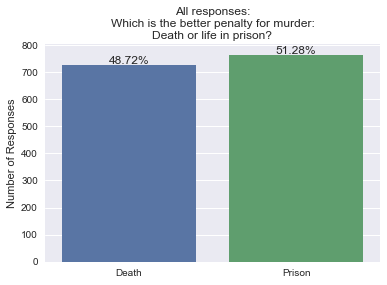Saluton, miaj samklasanoj! [hello, my classmates!]
I am going to examine whether people’s opinions of prisoners might be more favorable if they themselves have been accused or convicted of a crime or if they know someone who has. I believe that people who have firsthand experience with the defense side of the criminal justice system are going to be more empathetic towards people who are in jail or have been accused of a crime. I also believe this group will be more likely to oppose the death penalty or “three-strikes” laws (life in prison after a third felony conviction).
[Note: links to sources are embedded in the text below.]
I will be utilizing the Outlook on Life (OOL) surveys, made available by the Inter-university Consortium for Political and Social Research (ICPSR) and a special and generous arrangement that allows Coursera students to access this data. I get to take advantage of accessing a dataset that I would not have access to otherwise. This data was collected between August and December 2012. The target population was adults over the age of 18, divided into four groups of male- or female-identified African-American or Black individuals, and white or other (non-Black) race individuals.
A review of the prisoner’s rights movement between 1960 and 1980 suggests prisoners have the power to change public opinion and policy through the actions they’ve taken to advocate for their rights while incarcerated.
An interesting paper from 2008 describes public preference for “punitive policies,” but in the case of non-violent offenders and extreme punishments like the death penalty, support is weaker, and may indicate a preference of rehabilitation over the most severe of punishments.
A study in Chicago in 1988 found that despite increased punitive sentences, the general public was more supportive of the idea of rehabilitation over incarceration. However, a 2008 study in the United Kingdom found that people are perceiving crime to be more prevalent and violent despite falling crime rates, and that people feel less safe, implying that they may be more likely to prefer punishment over rehabilitation.
A 2003 article compared recidivism rates of sex offenders with public opinion and concluded that punishments are disproportionately severe and based on prejudices regarding recidivism rates, despite statistics on treatment options and recidivism rates.
In Perth, Australia, a survey of 544 residents in the 1980s found that people were more likely to recommend the minimum of three potential sentences when they were given the description of specific cases, compared to when they were asked for potential sentences for a general offense, suggesting that people may be more empathetic towards the accused if they see them as individual people rather than anonymous criminal offenses.
